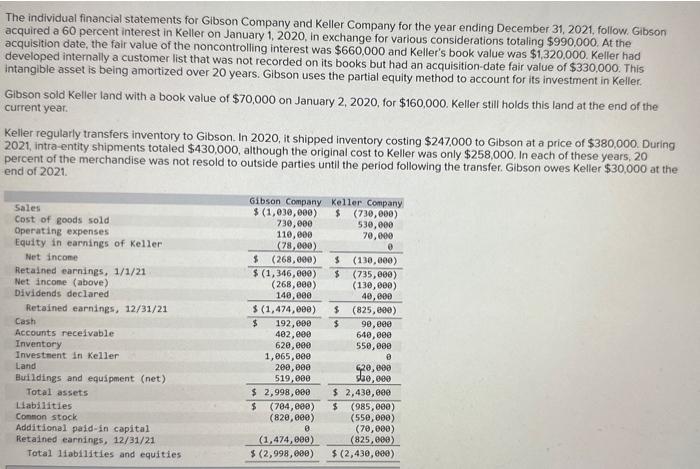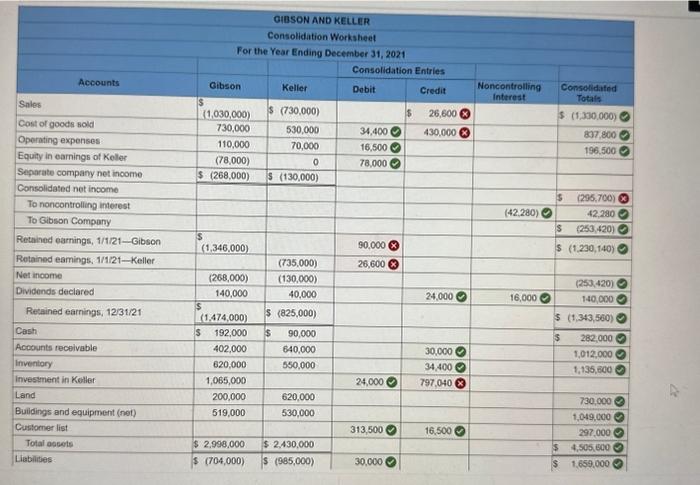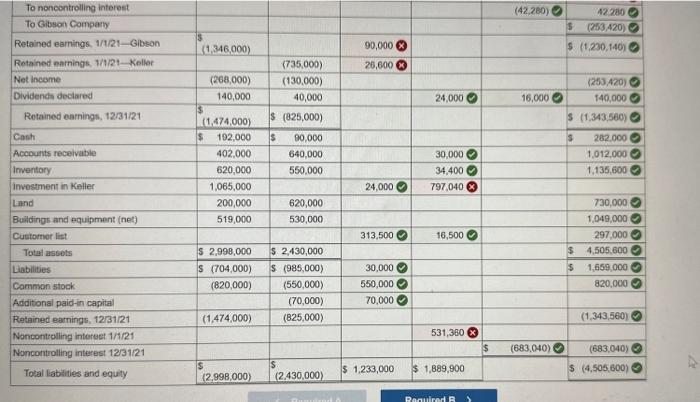Answered step by step
Verified Expert Solution
Question
1 Approved Answer
The individual financial statements for Gibson Company and Keller Company for the year ending December 31, 2021, follow. Gibson acquired a 60 percent interest in



 The individual financial statements for Gibson Company and Keller Company for the year ending December 31, 2021, follow. Gibson acquired a 60 percent interest in Keller on January 1,2020, in exchange for various considerations totaling $990,000. At the acquisition date, the fair value of the noncontrolling interest was $660,000 and Keller's book value was $1,320,000. Keller had developed internally a customer list that was not recorded on its books but had an acquisition-date fair value of $330,000. This intangible asset is being amortized over 20 years. Gibson uses the partial equity method to account for its investment in Keller. Gibson sold Keller land with a book value of $70,000 on January 2,2020, for $160,000. Keller still holds this land at the end of the current year. Keller regularly transfers inventory to Gibson. In 2020, it shipped inventory costing $247,000 to Gibson at a price of $380,000. During 2021, intra-entity shipments totaled $430,000, although the original cost to Keller was only $258,000. In each of these years, 20 percent of the merchandise was not resold to outside parties until the period following the transfer. Gibson owes Keller $30,000 at the end of 2021 . (Note: Parentheses indicate a credit balance.) a. Prepare a worksheet to consolidate the separate 2021 financial statements for Gibson and Keller. b. How would the consolidation entries in requirement (a) have differed if Gibson had sold a building on January 2. 2020, with a. $175,000 book value (cost of $370,000) to Keller for $330,000 instead of land, as the problem reports? Assume that the building had a 10-year remaining life at the date of transfer. The individual financial statements for Gibson Company and Keller Company for the year ending December 31, 2021, follow. Gibson acquired a 60 percent interest in Keller on January 1,2020, in exchange for various considerations totaling $990,000. At the acquisition date, the fair value of the noncontrolling interest was $660,000 and Keller's book value was $1,320,000. Keller had developed internally a customer list that was not recorded on its books but had an acquisition-date fair value of $330,000. This intangible asset is being amortized over 20 years. Gibson uses the partial equity method to account for its investment in Keller. Gibson sold Keller land with a book value of $70,000 on January 2,2020, for $160,000. Keller still holds this land at the end of the current year. Keller regularly transfers inventory to Gibson. In 2020, it shipped inventory costing $247,000 to Gibson at a price of $380,000. During 2021, intra-entity shipments totaled $430,000, although the original cost to Keller was only $258,000. In each of these years, 20 percent of the merchandise was not resold to outside parties until the period following the transfer. Gibson owes Keller $30,000 at the end of 2021 . (Note: Parentheses indicate a credit balance.) a. Prepare a worksheet to consolidate the separate 2021 financial statements for Gibson and Keller. b. How would the consolidation entries in requirement (a) have differed if Gibson had sold a building on January 2. 2020, with a. $175,000 book value (cost of $370,000) to Keller for $330,000 instead of land, as the problem reports? Assume that the building had a 10-year remaining life at the date of transfer
The individual financial statements for Gibson Company and Keller Company for the year ending December 31, 2021, follow. Gibson acquired a 60 percent interest in Keller on January 1,2020, in exchange for various considerations totaling $990,000. At the acquisition date, the fair value of the noncontrolling interest was $660,000 and Keller's book value was $1,320,000. Keller had developed internally a customer list that was not recorded on its books but had an acquisition-date fair value of $330,000. This intangible asset is being amortized over 20 years. Gibson uses the partial equity method to account for its investment in Keller. Gibson sold Keller land with a book value of $70,000 on January 2,2020, for $160,000. Keller still holds this land at the end of the current year. Keller regularly transfers inventory to Gibson. In 2020, it shipped inventory costing $247,000 to Gibson at a price of $380,000. During 2021, intra-entity shipments totaled $430,000, although the original cost to Keller was only $258,000. In each of these years, 20 percent of the merchandise was not resold to outside parties until the period following the transfer. Gibson owes Keller $30,000 at the end of 2021 . (Note: Parentheses indicate a credit balance.) a. Prepare a worksheet to consolidate the separate 2021 financial statements for Gibson and Keller. b. How would the consolidation entries in requirement (a) have differed if Gibson had sold a building on January 2. 2020, with a. $175,000 book value (cost of $370,000) to Keller for $330,000 instead of land, as the problem reports? Assume that the building had a 10-year remaining life at the date of transfer. The individual financial statements for Gibson Company and Keller Company for the year ending December 31, 2021, follow. Gibson acquired a 60 percent interest in Keller on January 1,2020, in exchange for various considerations totaling $990,000. At the acquisition date, the fair value of the noncontrolling interest was $660,000 and Keller's book value was $1,320,000. Keller had developed internally a customer list that was not recorded on its books but had an acquisition-date fair value of $330,000. This intangible asset is being amortized over 20 years. Gibson uses the partial equity method to account for its investment in Keller. Gibson sold Keller land with a book value of $70,000 on January 2,2020, for $160,000. Keller still holds this land at the end of the current year. Keller regularly transfers inventory to Gibson. In 2020, it shipped inventory costing $247,000 to Gibson at a price of $380,000. During 2021, intra-entity shipments totaled $430,000, although the original cost to Keller was only $258,000. In each of these years, 20 percent of the merchandise was not resold to outside parties until the period following the transfer. Gibson owes Keller $30,000 at the end of 2021 . (Note: Parentheses indicate a credit balance.) a. Prepare a worksheet to consolidate the separate 2021 financial statements for Gibson and Keller. b. How would the consolidation entries in requirement (a) have differed if Gibson had sold a building on January 2. 2020, with a. $175,000 book value (cost of $370,000) to Keller for $330,000 instead of land, as the problem reports? Assume that the building had a 10-year remaining life at the date of transfer




Step by Step Solution
There are 3 Steps involved in it
Step: 1

Get Instant Access with AI-Powered Solutions
See step-by-step solutions with expert insights and AI powered tools for academic success
Step: 2

Step: 3

Ace Your Homework with AI
Get the answers you need in no time with our AI-driven, step-by-step assistance
Get Started

